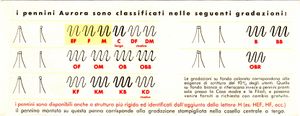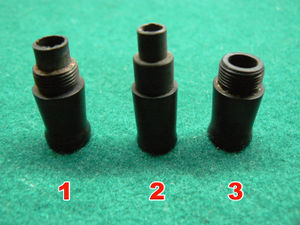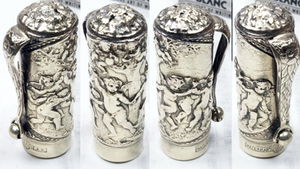Differenze tra le versioni di "Anatomia di una penna stilografica/en"
(Aggiornamento come da nuova versione della pagina di origine) |
|||
| (13 versioni intermedie di 2 utenti non mostrate) | |||
| Riga 1: | Riga 1: | ||
| − | [[Image:Parker-51-Aero-Burgundy- | + | [[Image:Parker-51-Aero-Burgundy-GFCap-Parti.jpg|thumb|Parts of a [[Parker 51]] ]] <onlyinclude> |
The distinguishing characteristic of a fountain pen is to be a tool combining a nib with an ink reservoir in a single writing instrument thus allowing long writing sessions without being continually interrupted by the need to re-dip the nib in the ink. | The distinguishing characteristic of a fountain pen is to be a tool combining a nib with an ink reservoir in a single writing instrument thus allowing long writing sessions without being continually interrupted by the need to re-dip the nib in the ink. | ||
</onlyinclude> | </onlyinclude> | ||
| Riga 5: | Riga 5: | ||
The success in creating a reliable tool that combined an ink reservoir to a nib is often traced back to the introduction of the multichannel feeder by ''Lewis Edson Waterman'' in 1884. Actually at that time there were already several producers who had built working fountain pens, whose essential elements remain the same even today. | The success in creating a reliable tool that combined an ink reservoir to a nib is often traced back to the introduction of the multichannel feeder by ''Lewis Edson Waterman'' in 1884. Actually at that time there were already several producers who had built working fountain pens, whose essential elements remain the same even today. | ||
| − | Some components are always present in every fountain pen: the combination of the nib and the feeder (the so called ''nib group''), the section (the end of the pen that holds the nib and feeder), the body of the pen, which is or contains the ink reservoir, and the cap (absent only on so-called [[desk pens]]). | + | Some components are always present in every fountain pen: the combination of the nib and the feeder (the so called ''nib group''), the section (the end of the pen that holds the nib and feeder), the body of the pen, which is or contains the ink reservoir, and the cap (absent only on so-called [[desk pens]]). The photos of these various parts have been collected in a series of galleries that can be reached starting from [[:Category:Gallerie|this page]]. |
| − | |||
== Nib == | == Nib == | ||
| − | {{:Pennino}} | + | {{:Pennino/en}} |
== Feeder == | == Feeder == | ||
| − | {{:Alimentatore}} | + | {{:Alimentatore/en}} |
== Section == | == Section == | ||
{{:Sezione/en}} | {{:Sezione/en}} | ||
== Barrel == | == Barrel == | ||
| − | {{:Corpo}} | + | {{:Corpo/en}} |
== Cap == | == Cap == | ||
| − | {{:Cappuccio}} | + | {{:Cappuccio/en}} |
== Clip == | == Clip == | ||
| − | {{:Fermaglio}} | + | {{:Fermaglio/en}} |
| − | == | + | == Case back == |
| − | {{:Fondello}} | + | {{:Fondello/en}} |
== Notes == | == Notes == | ||
<references/> | <references/> | ||
== External references == | == External references == | ||
* [http://www.nibs.com/article1.html] Article on nibs | * [http://www.nibs.com/article1.html] Article on nibs | ||
| − | |||
| − | + | {{CategorizeArticle|Tecnica}} | |
| − | |||
Versione attuale delle 15:07, 17 ott 2022
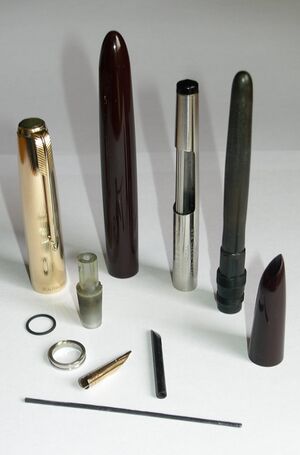
The distinguishing characteristic of a fountain pen is to be a tool combining a nib with an ink reservoir in a single writing instrument thus allowing long writing sessions without being continually interrupted by the need to re-dip the nib in the ink.
The first real fountains pens appeared around the end of 1800, although there were several predecessors designed for the same purpose, all poorly functioning. The success in creating a reliable tool that combined an ink reservoir to a nib is often traced back to the introduction of the multichannel feeder by Lewis Edson Waterman in 1884. Actually at that time there were already several producers who had built working fountain pens, whose essential elements remain the same even today.
Some components are always present in every fountain pen: the combination of the nib and the feeder (the so called nib group), the section (the end of the pen that holds the nib and feeder), the body of the pen, which is or contains the ink reservoir, and the cap (absent only on so-called desk pens). The photos of these various parts have been collected in a series of galleries that can be reached starting from this page.
Nib
The nib has always been one of the most important parts of a fountain pen, and plays the final role of bringing the ink on paper. Fountain pens nibs derive from dipping nibs; the main difference is that being fountain pens much more expensive objects with their nibs continuously in contact with the ink, these were traditionally made of gold to have greater resistance to corrosion of the inks of the time (with different carats, although the most common remains the 14 carat, followed by the 18 carat).
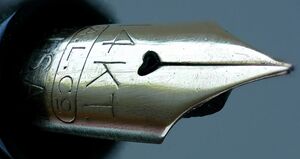
When with the evolution of technology it became possible to create steel nibs resistant to corrosion, the biggest obstacle to their spread became that of marketing, and still today we tend to think of a pen with a gold nib as of higher value, although on the technical level this is probably lower. Gold, although strengthened by the metals added to the alloys used to produce nibs, is a very malleable metal, and for this reason a gold nib is subject to bend permanently much more easily than any steel nib and in general ends up being much less robust.
A "gold" nib, however, cannot be entirely composed of gold (ie 24 carats), as mentioned this material is extremely malleable,[1] so it is generally strengthened by mixing it as with other metals to obtain 14 carat alloys, which are the most common, or 18 carat, used to give greater value to the pen, but generally less robust. The ancient pens are however for the most part equipped with 14 carat gold nibs, the 18 carats have been introduced only where, as in France, an object with a lower carat could not be qualified as gold for legal reasons.
In the period of the second world war, however, with the restrictions caused by the war, the use of gold for nibs was greatly reduced and in some countries, such as Germany and Japan, even explicitly prohibited. At that time there was a flourishing of various steel alloys, often renamed, especially in Italy, with imaginative and high-sounding names, and experimentation with alternative materials, such as palladium, which now seem to be back in fashion. But the use of steel for nibs can certainly not originate from the constraints of war. In fact, it was adopted by some producers, in particular those oriented to the lower end of the market, well before the war and for simpler economic reasons. Even in that case, however, they often tried to "embellish" the metal with a gilding.
Regardless of the strength of the alloy used to produce it, a nib must still have a tip properly reinforced, as the wear would be excessive even for steel. The tip must rub for miles and miles on paper, and to have a durable nib it is produced using a much harder material. In this case the most common choice is that of an iridium alloy, and this is why often, to indicate the state of wear of the tip of a nib, reference is made to the amount of iridium present on it, although in reality this tip may have been made with other metals (for example another choice is that of osmium, or various combinations of both).
Usually the tip of the nib is made melting directly on place a ball of iridium (or equivalent material), and then it is cut in two dividing the tip in the two tines for the realization of the slit through which the ink coming from the feeder must pass, and then suitably polished to offer a better smoothness. In general then, both to allow the air to escape from the conductor and to reinforce the end of the slit, the nib is equipped with the so-called "air hole", even if in many cases the only purpose for it is to give a better mechanical strength and flexibility. Some nibs also, such as the Triumph Nib of the Sheaffer, or the central nib of the Omas 361, are specially designed and machined to write from both sides, including therefore also the so-called dry side.
The nibs are classified classically[2] based on a series of numbers expressing their size, although more or less all manufacturers have adopted similar figures (with values ranging from 00 to 12) the numbers do not have a reference to a precise measure, but are simply a relative indication (a nib #4 is usually larger than a #2 of the same manufacturer), and are different between a manufacturer and another. Very often, see for example the Waterman numbers and the Montblanc numbers, they were also used to identify the different models of a production line.
| Sigla | Dimensione |
|---|---|
| EF | Extra-fine |
| F | Fine |
| M | Medium |
| O | Oblique Medium |
| B | Broad |
| BB | Double broad |
| BBB | Triple broad |
| OF | Oblique fine |
| OB | Oblique broad |
| OBB | Oblique double broad |
| M | Music nib |
| KF | Kugel fine |
| KM | Kugel medium |
| KB | Kugel broad |
Another possible classification is that made on the basis of the size and possibly the shape of the tip of the nib itself (fine, medium, wide, etc..). Even in this case, there is no universal standardization adopted by all, even if many manufacturers have ended up using abbreviations that are quite uniform among them, such as those shown in the table on the right, most of which are still in use today.
Again these are relative indications, and not adopted by all (for example Waterman in 1927 introduced a classification based on a colors code), so there may be considerable differences between nibs marked in the same way by differences companies; for example, for the different ways of writing in their respective countries generally a Japanese medium is equivalent to a European fine.
Also within the scope of the realization of the tip, in addition to references to dimensions, specific nomenclatures have been adopted to indicate in a generic way some particular versions of nibs, with specific characteristics determined precisely by the shape of their tip, for this further classification please refer to the pages of the following list that describe them one by one:[3]
- stub nib,
- italic nib or cut nib,
- italic cursive nib,
- round nib or kugel nib,
- oblique nib,
- musical nib.
A third possible classification, even less uniform in terms of terminology used, and which often has no official reference in the production of the various companies is that one relating to the greater or lesser flexibility of the nib, a classification that also tends to get lost in modern production, dominated by rigid nibs. One of the problems of fountain pens (considered a disadvantage against the ballpoint, and when solved used by manufacturer as a promotion factor for their pens) is that excessive pressure on the nib can harm the same, which makes it quite difficult to trace.[4] For this reason one of the few coherent terminologies is that of the so-called accounting nibs (accountant nib), often also called Manifold, very rigid and hard, usable for this reason also for accounting jobs where carbon paper copies were the norm.
Since there is no official terminology about flexibility, (even if some brands, such as Eversharp explicitly marked some of their flexible nibs with the words Flexible) the adopted one comes from the conventions established by collectors, and therefore also has a wide margin of randomness. We therefore decided, in a completely arbitrary way, to refer to the following definitions:[5]
- sprung: a nib that responds to pressure, but without creating a significant variation in stroke, many modern nibs declared flexible fall into this category.
- Demi-flex (semi-flexible): a nib which responds to pressure with a significant variation in stroke, but which is normally used without significant variation.
- Flexible: a nib which produces a variation in stroke even in normal writing, in response to small variations in pressure exerted on it.
- wet noodle (super-flexible): an extremely flexible nib, which must be used with care even in normal writing, leading to very accentuated stroke variations at minimum pressure.
Finally, being an essential element of the fountain pen, the nib has undergone some constructive variations by companies. Initially there was a differentiation carried out mainly in the construction materials of the body and the tip, but until the '30s has always remained virtually identical in form and function. The first significant diversification was the one introduced by Eversharp in 1932, with the variable flexibility nib called "Adjustable Point" equipped with a slider. But the most significant changes began in 1941, with the market release of the Parker 51, which marked the debut of the hooded nib. From then on there were evolutions such as the conical nib of the Triumph, the various versions of the winged nib from Wing-flow onwards, or the particular "inlaid nib'" introduced with the PFM.
Feeder
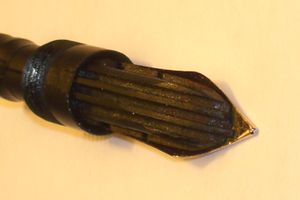
Although it is probably the least important part in the aesthetic aspect of a pen, the feeder (also called conductor or feed) is actually the heart of the working of a fountain pen, and on a technical level it is probably the most important component of it. It is in fact the feeder that creates the delicate balance of forces that allows the correct passage of the ink from the tank to the nib that deposits it on the sheet of paper, and a fountain pen writes well because its feeder does its job correctly.
The importance of this component is even more evident in the fact that the most important invention of Lewis Edson Waterman, the one that leads many to consider him (with some exaggeration) the father of the fountain pen, is related to the construction of the feeder. Of course, well before concentrating on materials and filling systems at the end of the 1800s, manufacturers were competing (and investing their research efforts) on this very element, which characterized their pens (think, for example, of Parker Lucky Curve or Waterman Spoon feed) since a well-functioning feeder was then what could lead to success or failure.
And although later on the importance of the feed, at least in the promotional material, has decreased at the expense of other parts and technical characteristics (and especially compared to the stylistic ones), it is still one of the essential parts of the functioning of a fountain pen, taken up in several cases by the manufacturers (as for the Eversharp Magic Feed or the Lamy tintomatic).
Apart from the still very primitive constructions present until the first years of 1900, which still provided for some companies (such as Swan and Onoto) the presence of the so-called overfeed the canonical shape of the feed as an element placed under the nib has been developing quite quickly.
Initially it was simply a cylinder of hard rubber suitably bevelled in the front part placed under the nib to leave space for writing, equipped on the upper part of the "channel" supply through which the ink arrives from the tank to the nib. The first variations occurred precisely in the construction of the channel, and in the addition of further grooves inside to facilitate the passage of the ink by capillarity. Through the same channel the air that replaces the ink that comes out of the pen tank flows (even if later possible alternative paths have been foreseen).

The first changes to the simple bevelled cylindrical shape occurred to solve the problem (then very pressing, but which still occurs today) to allow the blocking of the flow of ink when the pen is not used to prevent leakage in the cap. For this reason different solutions were adopted, with as many patents as the famous Lucky Curve of Parker, in which the rear part of the feeder was bent until it touched the wall of the tank, thus favoring (at least according to the claims of the project) the reabsorption of the ink.
Other solutions were produced for the same type of problem, such as the creation of appropriate side pockets next to the channel (as in the Spoon feed of Waterman). Over the years, the development of mechanisms has continued, either with the presence of engravings in more or less jagged shapes of the external part, as in the Parker Spear-head or in the variants of the comb feed created by August Eberstein (nº US-750271)) such as the Swan Ladder feed, or with the realization of fins, bags, engravings, channels and other configurations, to allow any excess ink to accumulate properly in the various folds, and avoid dangerous accumulations on the nib, in particular to compensate for pressure changes due to air in the tank, a problem that has become even more significant with the emergence of air travel. A photo gallery can be found on this page.
Section
It's called "section" the final block of the tip of the pen, the one in which the nib and feeder are inserted. The figure shows the three most common types of section present on antique pens, corresponding to three different types of filling system; for more details on this type please refer to the page on "section types and repair". A further nomenclature related to the section is that of the so-called "nipple", present only on some types of section (in the figure types 1 and 2), used on pens whose filling system requires the presence of a sac, which is usually glued on the collar.
The section is present on almost all the fountain pens except for some particular designs like PFM, where the nib is directly inlaid on the section and then protrude, or as in the Parker T1 or the Pilot Murex where the nib is the continuation of the metal body. To these specific exceptions are added all the safety, which for construction mode do not have a section, being the nib retractable inside the body of the pen.
The section, in addition to be used to keep in contact nib and feeder, is also the most common grip point of the pen in the writing phase, and for this it generally presents a flared part that allows a more secure grip. In some cases, as in the Parker 75, this is also suitably worked or shaped with ergonomic shapes (triangular, in the case cited) to offer specific support surfaces for the fingers that facilitate the handle.
Apart from this, the section is generally the part of the pen traditionally less subject in itself to innovations of a technical and stylistic nature, even if there are particular models that have some specific features such as the aforementioned Parker 75 with the ring for positioning the nib or the first series of Crest with the thread on the top of the section itself or the special sections with transparent window (the Visulated of the Sheaffer) used to make the ink level visible even with pens equipped with a loading system that generally does not allows it (as for example in the Balance and in the Doric with lever filler).
Barrel
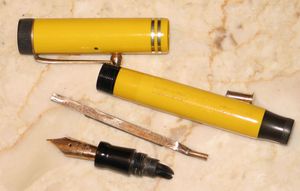
The barrel, or body is usually the largest part of a fountain pen. In modern cartridge filled pens it has practically no other role than to provide support for the use of the pen and cover the cartridge, but initially, when the pens were loaded with droppers, it was used directly as an ink tank. This role is still played today with some filling systems such as the piston filler or plunger filler, in which case it is often equipped with transparent parts (windows or entire sections) to allow the display of the ink level.
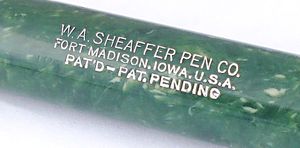
Even when the ink is not contained directly in the barrel, or in a part of it, but in a separate tank, as with all loading systems that use a rubber bag, the body still plays the role of container both for the latter and for the filling mechanism itself. Moreover, especially in the productions up to the '40s, it was typical to find the engravings of the brand and of the name of the producer (as well as of the possible patents of the pen).
Initially, also for the greater facility of working, it was realized in cylindrical form with flat ends (the so-called flat top) but following the evolution of the stylistic tendencies it has been passed to more tapered forms (with the birth of the so-called streamlined style). Moreover, with the evolution of stylistic trends from the ordinary round section, we have moved to multifaceted, triangular, square, octagonal, dodecagonal forms, etc.
In addition to differentiating itself for the various forms adopted by the producers, the barrel has also undergone the evolution in the use of the materials used in the construction of the fountain pens, of which it constitutes the largest component. At the dawn of the fountain pens it was mainly made of hard rubber like the rest of the pen, a material that guaranteed, having to serve as an ink tank, the necessary chemical resistance.
With the development of the technology all the other materials have been used then, starting from the metal (the first were probably the Wahl Metal Pen), the first artificial resins such as bakelite, galalith and celluloid, to pass in the '40s to the most common plastic resins still in use today. A photo gallery is on this page.
Cap
Apart from some particular designs (the Pullman of Météore, the Asterope of Aurora and the Capless of Pilot) the cap remains one of the essential components of a fountain pen. The cap basically performs two functions, on the one hand it provides the protection of the nib against accidental bumps to the outside, on the other hand it protects the outside from accidental contact with the nib (and especially with the ink brought by the same) and from any leaks. A photo gallery of different types of caps can be found here.
From a technical point of view, many inventions have been applied to the cap, almost always related to the way in which it can be opened or closed (interlocking, screw, snap, now also magnetic) and sometimes also to the way in which it can be inserted on the bottom of the pen to balance the weight or size of the same, as in the case of the Pilot Elite (but there are many precursors) in which for the use of the pen it was necessary to put the cap on it because this was a necessary extension of the body.
A second role played by the cap is to keep the environment around the nib well circumscribed, with the pen closed, so that the ink present on it does not dry out (causing a difficulty in restarting) on the one hand but does not even undergo pressure changes that can cause ink to escape. For this reason, there are both ventilated caps (with the presence of ventilation holes) and caps that are completely sealed. In particular, at the beginning of the 1900s, in order to guarantee against the loss of ink, the presence of a second inner cap began to be introduced as a constitutive part of many caps (significant patents nº US-764227 and nº US-1028382), which encloses the part on which the section is bent and isolates it from the rest of the cap, guaranteeing the seal of the ink. Sometimes this same element is also used as a locking component in the assembly of the clip, which can be mounted in a ring on the same, or wedged between the cap and inner cap by means of a lateral slot.
The cap is also often a characteristic element for the design and lines of a pen, and can be the subject of various decorations. Among these, a common element, widely used and still present on most of the caps, are the bands, or the various rings, whose original purpose was also strictly practical in nature. The edge of the cap is in fact one of the most stressed and subject to the risk of breaking a pen, and the original use of rings and metal bands (see patent nº US-662796) was precisely to reinforce the edge, and only later these have assumed the character of a decorative element.
Historically, the first caps were made with a friction closure (those that are generically defined slip caps), with the cap that fits on the body. There are different variants of this type of choice, depending on the way in which the joint is made; the two main classes are the so-called cone cap (conical section cap) in which the interlocking surface is a truncated cone, and the so-called straight cap (cylindrical section cap) in which the interlocking surface is cylindrical, among the latter there are then the so-called tapered cap (conical or tapered cap) in vogue at the end of the 19th century.
The interlocking caps which suffer, especially in the conical version, from problems of wear on the surfaces with loss of tightness, have been followed, with a trend established since the beginning of the '900, by the caps with screw closure (threaded cap), which are still among the most common today. A return of the interlocking caps took place in the '40s with the introduction of metal caps closed with friction on special rings (trend introduced by the Parker 51).
Towards the end of the 1940s, the first snap-action caps began to spread (one of the first companies to use them was the Matador with the Matador-Click model of 1949), which later became very common and still widely used. In this case, the quality of the mechanism is essential to ensure the long-term maintenance of the cap closure. A photo gallery can be found on this page.
Clip
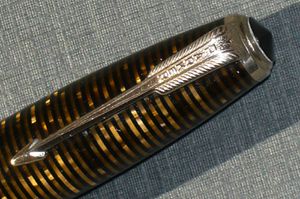
Although the first fountain pens were not equipped with a clip and there are for example suitable pocket cases for the same (they are very typical of the Swan) the use of the clip (usually placed on the cap) has quickly established itself as an essential element to allow a simple attachment of the pen to the pocket of the shirt or jacket, becoming one of the most relevant components, present on the vast majority of pens.
In addition to the first older models, when the use of the clasp was not yet established, are generally an exception to its omnipresence pens for women, with a ring and chain to be worn as a necklace, or handbag pens to be kept in a pocket of the same, usually small size. Another exception are the desk pens, which do not use it being positioned in their housing on the base.
As for the other elements that make up a fountain pen, the clip became very soon a distinctive element of the pen, often going beyond its strict technical meaning to become a stylistic reference, such as the Parker arrow clip, still today a distinctive element of the company, or the shape that recalls the pelican beak used by the Pelikan. Not to mention indirect stylistic requirements, such as those imposed by the military regulations of the American army, which prohibiting the protrusion of the pen from the pocket have resulted in a particular conformation of the same.
But if in the history of the fountain pen the clip has distinguished itself mainly as a stylistic element, it has also played a not insignificant role on the technical level, starting from the various methods of assembling it (such as the washer mounting), or the measures to facilitate its introduction in the pocket (the Roller Clip of the Eversharp), to block the screwing of the cap (the Lox-Top of the Chilton) or to block the clip on the jacket (the hook clip of the Novum). A photo gallery can be found on this page.
Case back
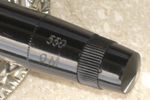
Although it is not as widespread and common as the other elements dealt with so far, many models have, usually associated with their loading mechanism, a case back that covers the rear part (in relation to the nib) of the body of the pen. This element is not always present, as for many pens the back end is simply part of the shaft of the pen. A photo gallery of different types of knobs can be found here.
In many cases, a case back is only present for aesthetic and decorative reasons and may in turn contain specific decorations or inscriptions, such as the model number, but it is fixed. In other cases it is used to cover the access to the filling system (it is common in button fillers) and can be detached, usually by unscrewing it to access the mechanism, but in this case it has to be more properly called blind cap. Finally, the case back can be a direct part of the filling system itself (for filler such as the piston filler or the plunger filler) in which it generally plays the role of the part of the mechanical device (and then is better called knob) on which to act to activate the filler.
Notes
- ↑ malleable (see this Wikipedia entry) is meaning a very soft material, easy to deform without losing its mechanical properties, in essence the exact opposite of strength and flexibility, gold is one of the most malleable materials that exist.
- ↑ by classically it is meant referring to the initial period of the spread of the fountain pen, this type of classification has now virtually disappeared.
- ↑ some examples of how you can classify the tips found here.
- ↑ Today the problem hardly exists with the spread of digital, but it was not trivial when copies had to be made by tracing with carbon paper.
- ↑ we started from the definitions of Davis Nishimura, as reported in this article even though they are not completely followed.
External references
- [1] Article on nibs
